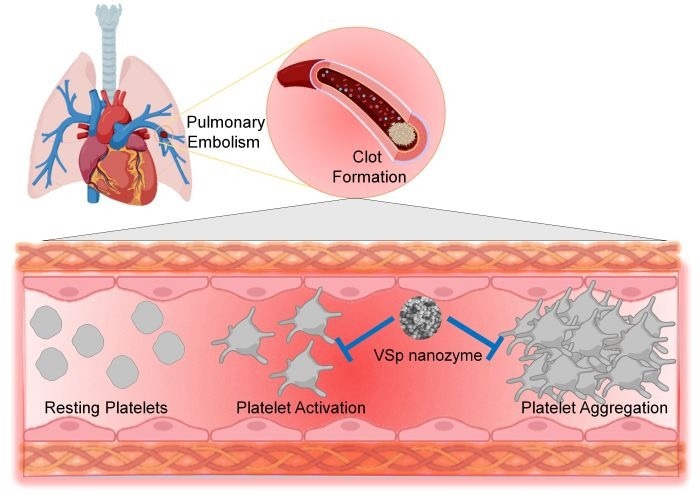Reviewed by Lexie CornerJun 5 2025
A study published in Angewandte Chemie reports that researchers at the Indian Institute of Science (IISc) have developed an artificial metal-based nanozyme. It may help prevent irregular blood clotting linked to conditions such as pulmonary thromboembolism (PTE).
 Prevention of platelet activation and pulmonary thromboembolism by VSp nanozyme. Image Credit: SharathBabu BN
Prevention of platelet activation and pulmonary thromboembolism by VSp nanozyme. Image Credit: SharathBabu BN
Under normal conditions, specialized blood cells known as platelets are activated when a blood vessel is damaged. They group together to form clots that protect the vessel. This process, known as the blood clotting cascade or hemostasis, involves a complex sequence of protein interactions. It is triggered by signals from chemicals such as thrombin and collagen.
In disorders like COVID-19 or pulmonary thromboembolism (PTE), these signaling pathways can malfunction. This leads to increased oxidative stress and higher levels of reactive oxygen species (ROS), which cause platelets to become overactivated. As a result, too many clots can form in blood vessels, leading to thrombosis, a major cause of illness and death.
To address this, a team led by Professor G. Mugesh from the Department of Inorganic and Physical Chemistry developed nanomaterials that mimic natural antioxidant enzymes. These “nanozymes” help regulate ROS levels and prevent platelet overactivation, reducing the risk of excessive clot formation.
The researchers used controlled chemical methods to create redox-active nanomaterials with different sizes, shapes, and structures. They then extracted platelets from human blood, activated them using chemical signals, and tested how well the nanozymes prevented excessive platelet clumping.
They found that spherical vanadium pentoxide (V2O5) nanozymes were the most effective. These materials mimic the function of glutathione peroxidase, a natural antioxidant enzyme that reduces oxidative stress.
It was challenging to get the pure form of the nanozyme with only the +5 oxidation state of vanadium oxide. This was important because the +4 oxidation state is toxic to the cells.
Sherin GR, Study Lead Author and Ph.D. Student, Indian Institute of Science
“The unique chemistry of the vanadium metal is crucial because the redox reactions that reduce ROS levels are happening on the surface of the vanadium nanomaterial,” added Mugesh.
The scientists tested the nanozyme in a mouse model of pulmonary thromboembolism (PTE) and found that it reduced thrombosis and improved survival rates. They also monitored the animals' weight, behavior, and blood markers for five days after treatment and observed no harmful effects.
Current antiplatelet drugs used to treat thrombosis can increase the risk of bleeding.
Unlike conventional anti-platelet drugs that interfere with physiological haemostasis, the nanozymes modulate the redox signaling and do not interfere with normal blood clotting. This means that they won’t cause bleeding complications that are a major concern with current therapies.
Bidare. N. SharathBabu, Study Lead Author and Ph.D. Student, Indian Institute of Science (IISc)
The research team now plans to explore whether the nanozyme can also help prevent ischemic stroke, which is caused by blocked blood vessels.
“We are hopeful about clinical studies in humans because we have done our experiments with human platelets, and they worked.”
Journal Reference:
Sherin, G. R., et al. (2025) Vanadia Nanozymes Inhibit Platelet Aggregation, Modulate Signaling Pathways and Prevent Pulmonary Embolism in Mice. Angewandte Chemie doi.org/10.1002/anie.202503737.